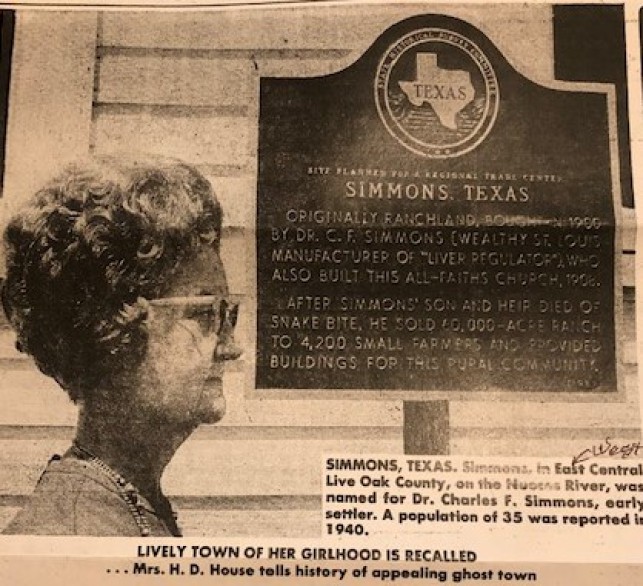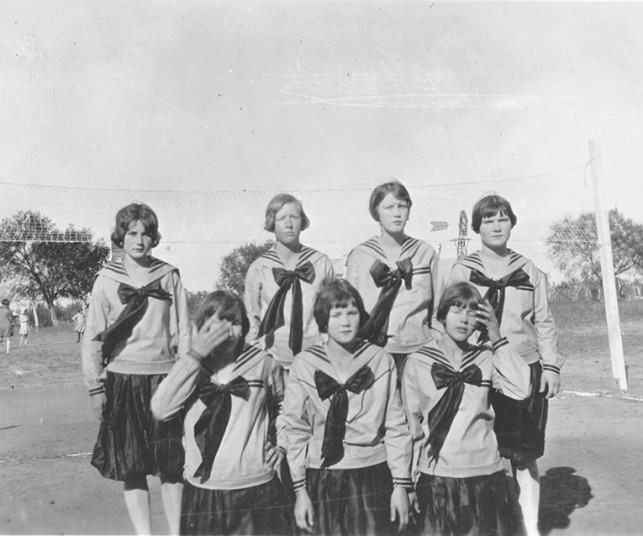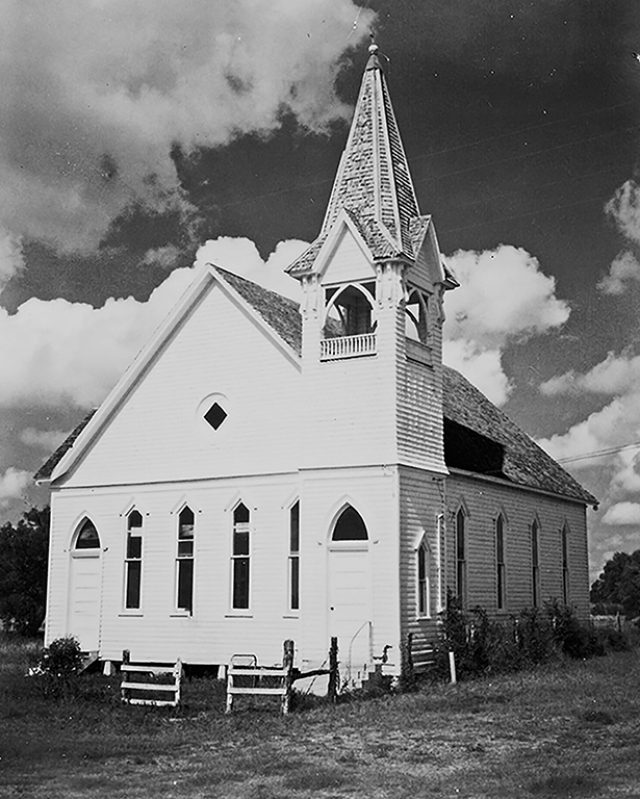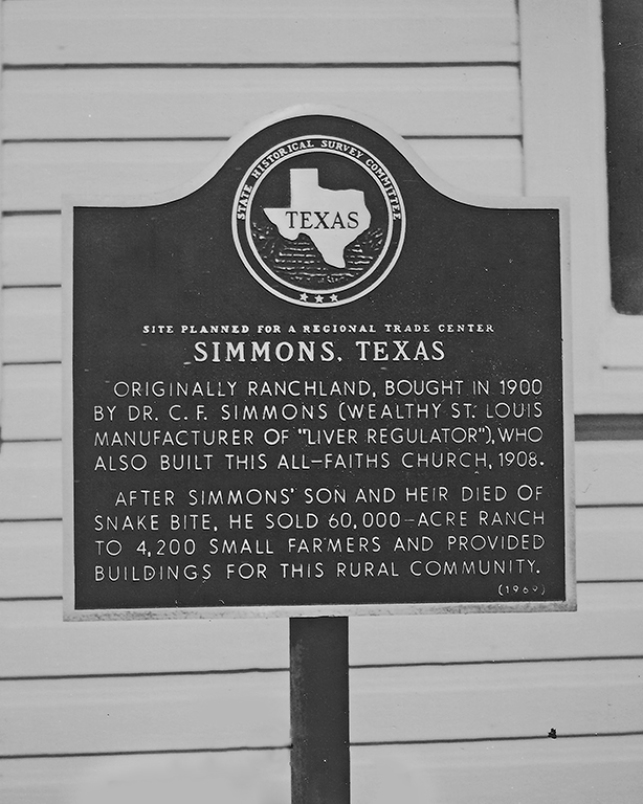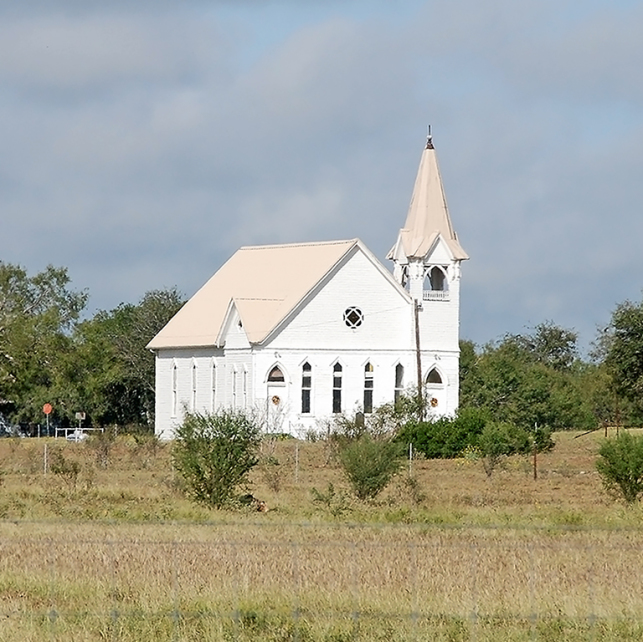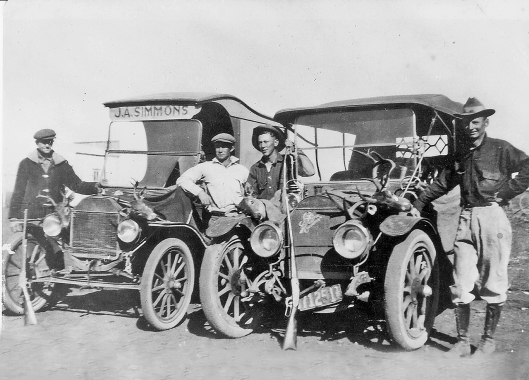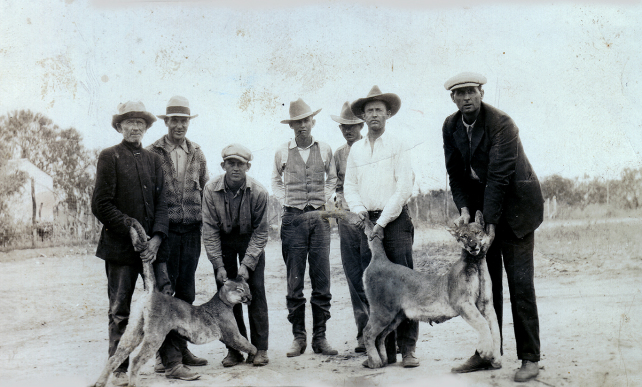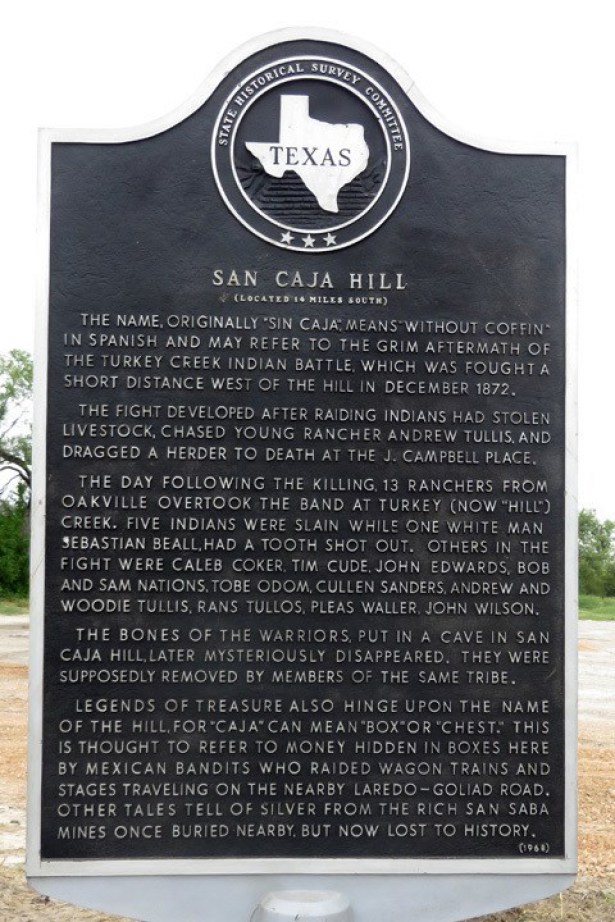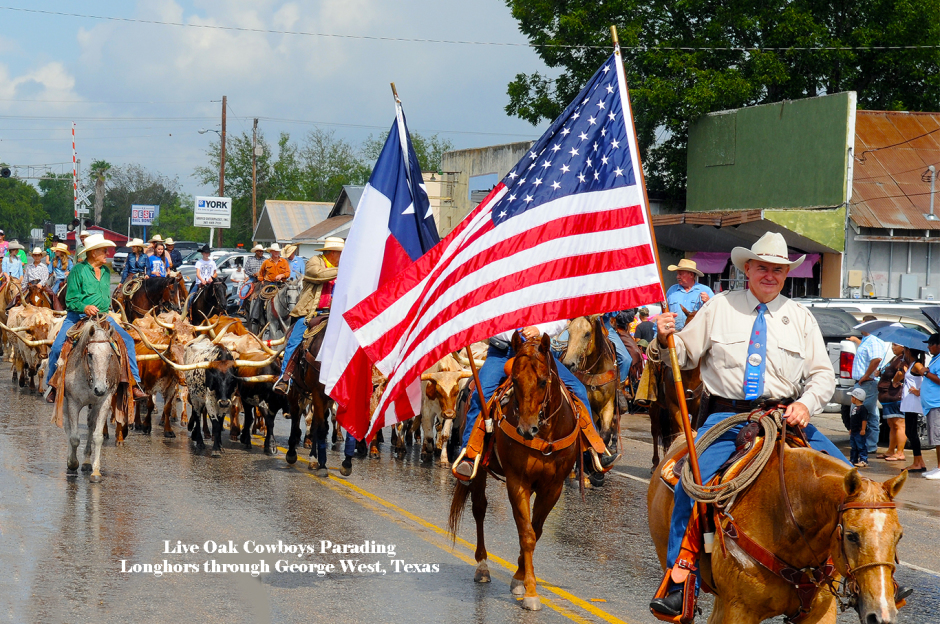
Simmons-Once known as Simmons City
Interesting characters abound in Live Oak County history. The founder of Simmons City, Dr. Charles.F. Simmons has to be one of the most extraordinary! This third generation doctor, not only had medical degrees but a law degree and legal licensed jurisdiction in seventeen states. As grandson, Charles' job was filing and pursuing suits against those who violated the grandfather's copyright. His grandfather's copyrighted "Dr. Simmons Liver Regulator" sold for 35 cents a bottle and created a family fortune. Charles himself was noted for daring and his many Affairs of Honor (duels) which he continually won. It was said he carried a derringer in each sleeve at all times. He came to Texas from Missouri in 1899 because his doctor recommended the climate. Live Oak County records his first land purchase there in 1900. He also made purchases elsewhere.
Long before The Handbook of Texas Online began, The Handbook of Texas was published annually in hardback and then softback. The photo above comes from one of those editions. George Carmack, commissioned by The San Antonio Express - News, along with his photographer wife, Bonnie Carmack, decided this photo and text did not do justice to the story of Simmons. So they published the following article by interviewing Mildred House (in the photo with Simmons Texas Historical Marker). Article published in the San Antonio paper on Saturday, September 14, 1974 furnished by Kurt House, Mildred's son. Carmack's account of Mildred House's interview edited and posted below in daily episodes.
Simmons is Fascinating--
by George Carmack
The Texas Handbook, authority on all things Texan, could not have been more matter of fact in the paragraph inset in the photo above.
But back of that short paragraph lies another fascinating Texas story.
A story of a once lively town with several hundred people, stores, a bank, post office, school and even a two-story hotel -- now a ghost town.
What's left of the old town founded 67 years ago [114 years as of this writing in 2021] is the church built in 1908 -- and crumbling walls of the hotel.
Bonnie and I learned about Simmons, Texas from Mr. and Mrs. Harold D. House of Three Rivers. The Houses own the "Mother-Lode Ranch" that lies within 60,000 acres Simmons developed. Both are interested in history and have some fine material on Simmons development.
Simmons High School Girl's Basketball team, 1927. Girls played half-court only against a second team. Forwards for one team and guards for the other on each half. The dirt floor was also used for tennis. Their uniforms homemade. Some of these young wormen lived in Simmons or within Live Oak County their entire lives and have descendants living there now. Alphabetical list of young ladies: Corrinne Autry, Martha Carroll, Lillie Cleveland, Gladys Farrier, Thelma Hicks, and Nora Sawyer. One unidentified. Photo courtesy Lois Matkin for Richard Hudson collection.
Both Houses' families moved to Simmons when they were young in the 1920s. The town was still active then. Mrs. House was our guide on this visit. She also asked 84-year-old A.T. Secrest to go with us. He moved his family to Simmons in 1918.
From Secrest and the Houses we learned Dr. Simmons lived at Excelsior Springs, Missouri before coming to Texas. Simmons grandfather developed a patent medicine, "Dr. Simmons' Liver Regulator". It made the family millionaires.
At some point, Grandson Dr. Charles Simmons decided to buy a ranch in Texas for his son, Harry. Harry's age is not known but reportedy, he was "a grown man." [A Beeville Picayune account reported his age as 29, and married with two children.]
Rattlesnake Bite
Simmons' son was on the ranch in 1905 and bitten by a rattlesnake. The bite was so high on his thigh that a tourniquet was not possible. There are several versions of how Harry was bitten.
"I once had an old Mexican working for me who crossed the Border years before," Secrest ventured. "He told me he was working beside Simmons when he was bitten.
"He said a group was clearing out 'senderos' (trails) when they heard a big rattlesnake rattle. He said Simmons had never seen a rattlesnake and sprang forward to take a look. The old man said that Simmons even stooped down like he was going to pick up the snake.
"Then the snake struck him."
Old-Timer Graves Peeler says he was told years ago Simmons was sitting with a group of cowboys around a campfire when the rattlesnake struck. The ride to save him must have been one of the most dramatic in Texas history.
House reports he was put in a hack behind the best horses available and a mad dash started for Beeville, 40 miles away, but the nearest place with a doctor.
Men on horseback rode with the hack to speed the trip.
"I once talked with a man who saw the hack and riders here in the Three Rivers area," House continued. "This was only a fraction of the way--yet young Simmons was already badly swollen and could not talk.
The trip was futile and young Simmons died."
See "Incredible Trade Center Plan Develops" below. (From 1981 LOCHC People's History. Carmacks' article returns here.)
Incredible Trade Center Plan:
[After the death of his son:] Dr. Simmons then decided to sell the ranch and his promotion had the touch of genius.
The Houses report he divided the 60,000-acre ranch into 4,200 farms and set up the town of Simmons with 4,210 lots.
Everybody got a town lot thrown in if he bought a farm. But the big "pull" was this -- All purchasers bought an "application" for a small down payment and monthly payments. But the buyer did not know what size farm he would get.
Simmons divided the land into 2,529 farms of five acres, 935 of 10 acres, 175 of 40 acres, 81 of 80 acres -- and finally five big farms of 640 acres.
When all applications were sold, there would be a drawing -- with the size of the farm depending on the slip drawn. Every buyer, of course hoped he would get one of those 640-acre farms -- or at least 80 acres.
With the death of his son, Harry. Simmons lost interest in the ranch. He attempted to sell. An interesting event, told in The History of the People of Live Oak County, Texas below the present article, turned Simmons from immediate sale to a grand scheme. He would turn the ranchland into a trade center surrounded by small farms and ranches. Photos above show the all faiths church building he built and the Texas Historical Marker about the community placed in front of it shortly after the marker was erected some 60+ years later.
Simmons, a once robust community, is still active in this iconic church building with its small congregation and use as a community center. (Photos Richard "Hud" Hudson collection. Bonnie Carmack photos did not appear in the paper and are not now available.)
The Simmons Church building as seen today. Photo by Richard Hudson. Look closely through the new growth of the second bush from the left and see the Texas Historic Community Subject Marker placed there in 1969 standing in front of the building. Carmack story continues:
Anniversary
This week [Article published September 14, 1974. Anniversary celebrated in the church.] is the 67th anniversary of the big drawing. The drawing was held at the Simmons townsite Sept. 10, 11, and 12, 1907. Buyers were there by the hundreds from all over the U.S.
Mrs. House, Secrest, Bonnie and I approached Simmons from the side of town where the drawing was held. A big tree now grows in an open field near the point of the drawing.
Across the road is what was once the Town Square. Here a barbecue was held.
The square has now grown up in brush. There had been a rain a few days before we were there. The square was filled with the soft lavender blossoms of the sage -- mixed with the delicate ivory of the "white brush".
'Streets'
The four of us [George Carmack, his wife Bonnie, Mildred House, and A.T. Secrest] drove up and down the "streets" Dr. Simmons had laid out. Mrs. House and Secrest enjoyed a hundred memories --
"There was where the drugstore was ... and where that new house is was the post office ... there is where the House family lived when they left the hotel ... the school was over there ... so-and-so lived there ..."
We stopped by the white wooden church building that outlived every other Simmons building. Dr. Simmons had it built with lumber hauled from Beeville by four and six-horse teams. It has been well kept and religious services are still held there. As the only building left, it is a community meeting place. And it must be one of the few church buildings in which political elections are held.
Chairman
Secrest has been Democratic precinct chairman for 50 years -- a tribute to the admiration his neighbors have for him. From a few things he said, Secrest plainly is no admirer of Herbert Hoover.
Simmons Hotel
Bonnie and I were particularly touched by the ruins of the old gravel and cement hotel. Only a part of the crumbling wallls stands and a rough shed has been built next to one wall. Several mesquite trees have grown up since the last guest checked out years ago.
And the brush and grass are growing amid the ruins.
As Bonnie was photographing all that remains -- a big lizarad glided over the wall and out of sight.
The House family once owned the hotel and operated it for several years in the 1920s.
Game hunting was major sport and drew many visitors to the hotel. As one can see these hunters are quite proud of their trophies. It's said even New York executives still come and stay in ranch lodges for special game, especially deer in the area. Mountain lions and cougars were menaces and are practically extinct. For many years the state paid bounties for menaces like panthers, mountain lions, and cougars. Photos of game hunters above courtesy of Lois Matkin placed in Hudson Collection.
Carmack continues:
Later in the day Bonnie and I went with the Houses out to their ranch -- a story in itself with its rocks such as petrified pieces of palm and "fern bud."
Out across mile after mile of Brush Country to the southwest, there was an unusual mesa -- a low mountain shaped like an old-fashioned hay "rick".
[]A low table-top mountain "mesa" visible from the House's ranch in Live Oak County, now home of Mission Sin Caja erected in his parents' honor by their son, Kurt "Cowboy" House. Sin Caja and the marker above sit in McMullen County. Photo by Waymark.
Adapted from The History of the People of Live Oak County, Texas, published by The Live Oak County History Book Committee, 1982, pp. 17-23. (This entire passage below lends some lively tales of the early development of Simmons and its originator, Dr. Charles F. Simmons. However, because of its length is immediately condensed in this version but will be lengthened to include the whole story as time permits.)
According to Dr. Simmons account, the community began as the Simmons Ranch over time as he purchased 60,000 acres at $2.00 an acre. The ranch home site was developed about 1900 ...
Incredible Trade Center Plan Develops:
Rumors about how Simmons hit upon the disposition scheme are interesting tales ... but there is no way to substantiate them. It is possible that he adapted the government's lottery plan for the sale of Indian lands, as registration was in progress for those lotteries at that time.
One yarn is that a young man appeared at the Simmons Ranch in a rig rented from a Beeville livery stable and, after too brief an inspection to warrant a purchase, offered Simmons a cashier's check for $50,000 as a down payment on the ranch.
Curious as to how the fellow throught he could turn a profit on the land at the price he was offering to pay, Simmons asked what he had planned to pay for the ranch. The man outlined a raffle he had in mind. Simmons infuriated at his audacity, chased the young man off with his handy sleeve derringers, and t was reported that the retreat was so hasty that one of the horses died of exhaustion upon reaching the livery stable.
But, so the anecdote continues, Simmons and his family sat up all night figuring out the detais for such a drawing, and the next morning Simmons delivered two morrall bags of letters to the Oakville Post office, putting the plan in action.
See "Incredible Trade Center Plan" above.
